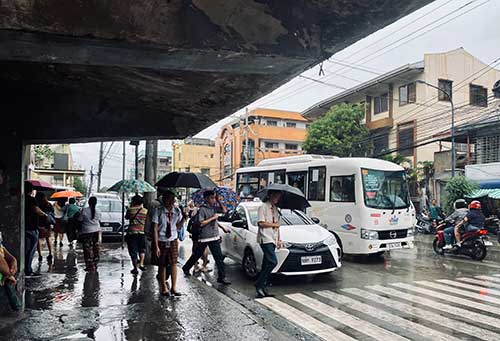
By Mariela Angella Oladive, Rjay Zuriaga Castor and Juliane Judilla
Face-to-face classes in Iloilo City resumed on September 19 after a three-day suspension due to the enhanced southwest monsoon (habagat).
The decision to reopen schools followed an assessment by the city’s Emergency Operations Center (EOC), which determined that weather conditions had improved enough for classes to resume safely.
The suspension, which began on September 16 due to Tropical Depression Gener, affected hundreds of families across the city.
While many welcomed the return to classes, reactions were mixed among students.
Aaron, a first-year college student at a private merchant marine school, shared his concerns with the Daily Guardian: “It was nice to have a break, but I’m anxious about the upcoming prelim exams.” He noted that during the suspension, students were given take-home assignments to make up for missed lessons.
Michell Dizon, a Grade 12 STEM student, expressed relief but also some worry. “Attending online classes is convenient since I save on commuting, but I’m concerned about how I’ll perform in exams, especially with the interrupted class schedules,” she said.
For younger students, the absence of in-person classes posed additional challenges. A Grade 6 student mentioned struggling to keep up with schoolwork without the usual classroom guidance, while Marilyn, a caretaker of a Grade 2 student, explained the difficulties of remote learning: “Teaching at home is hard, but it’s better than risking their safety in bad weather.”
Beyond the schools, the local economy also felt the effects of the rain. Street vendors reported slower sales as fewer customers ventured out, and transport services faced challenges.
Ryan, a delivery rider, shared his experience: “Sales have been slow, and sometimes it’s not worth making deliveries in these conditions.” However, taxi drivers like James saw a different trend: “More people are taking taxis during the rain because it’s safer, so sales have increased,” he noted.
According to the latest report from the Iloilo City EOC, 565 individuals across 11 barangays were affected by strong winds and rough waves as of September 18.
The storm damaged 109 houses, with six totally destroyed and 103 partially damaged.
Additionally, 15 trees and five electrical posts were toppled, and seven barangays remained flooded.
Despite these setbacks, the city is gradually recovering, and the resumption of face-to-face classes marks a return to normalcy.
The EOC urged students and families to stay informed through weather advisories and remain in contact with schools and local disaster management offices.
The EOC forecasts cloudy skies with occasional rain showers and isolated thunderstorms in the coming days.
Residents are advised to carry umbrellas, raincoats, and boots as light rainfall is expected between 3 and 6 a.m., with improved conditions later in the day.
BFAR-6: ANTIQUE FISH SAFE TO EAT
The fishes caught in the waters of Antique, particularly in the town of Sebaste, are safe for human consumption, the Bureau of Fisheries and Aquatic Resources Western Visayas (BFAR-6) said.
Several Facebook posts surfaced claiming that fishes in the Antique waters have fed on the flesh of cadavers after tombs at the Aguila Public Cemetery in the coastal area of Sebaste were damaged by strong waves over the weekends.
BFAR-6 Director Remia Aparri told Daily Guardian that the consumption of fish captured in the province is “generally safe,” citing the feeding habits of fish present in the area.
She explained that fish are categorized as either surface feeders or bottom feeders. Surface feeders, including commercially important pelagic species, feed on algae, plankton, and small fish.
“Surface feeders are not known to have a feeding habit where they eat fresh or dead persons or animals. They are not carnivorous,” she stressed.
Some surface feeder fish are milkfish, sardines, mackerel, and flying fish.
She also emphasized that these kinds of fish are migratory, which means that they constantly move and are less likely to come into contact with floating cadavers.
“Cadavers tend to end up along the coastline, while commercially important fish are usually found farther from the shore. This further reduces the risk of contamination,” she highlighted.
Aparri also pointed out that while bottom feeders may be carnivorous, they do not typically feed at the surface where cadavers float and this behavior also minimizes the likelihood of fish consuming human remains.
“The statement that the fishes are not safe to eat should not apply because based on science or the characteristics of the fish, they are not feeding on dead animals, including humans,” he further reiterated.
FIVE CONFIRMED DEATHS IN WV
Five people have died in Western Visayas due to Typhoons Ferdie and Gener between September 13 and 17, 2024, according to data from the Office of the Civil Defense Region 6 (OCD-6).
The OCD-6 confirmed the fatalities in an interview with RMN Iloilo on Wednesday.
The deaths were recorded in the following provinces: Antique – 1; Negros Occidental – 1; Bacolod City – 1; Iloilo – 1; and Guimaras – 1.
Most of the deaths were caused by drowning in rivers and coastal areas.
In Bacolod City, a five-year-old boy fell into a drainage system and was swept away by strong currents on Saturday, September 14. His body was found along the Bacolod City shore on Monday, September 16.
In Tigbauan, Iloilo, an elderly person drowned after diving into the water to retrieve a fan blade.
In Pandan, Antique, a person was swept away by the current while crossing a river to retrieve their carabao.
A similar incident occurred in Hinoba-an, Negros Occidental, where a person drowned after underestimating the strength of a river’s current while attempting to buy drinks.
Another fatality was recorded in Sipalay, Negros Occidental, where a group of children had been swimming in the sea despite warnings from their grandmother.
Two of the children entered the water, but only one made it back to shore.
OCD-6 is still investigating whether this case can be classified as a typhoon-related incident, as the children had been warned of the strong waves.





















